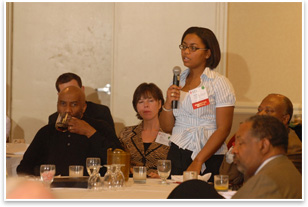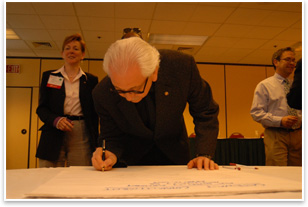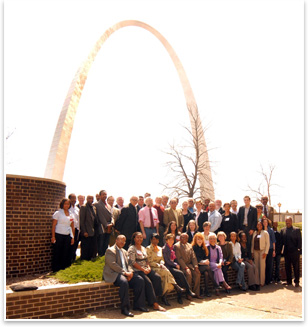
| Diversity Plenary Crafts Gateway Commitment to Diversity Participants embrace concept of diversity “pipeline”
The backdrop for the meeting was a directive from the 2008 AIA Strategic Plan: “Expand the diversity of the design professions to mirror the society we serve.” Notes Karen Davis, senior director, AIA Strategic Planning: “Things aren’t homogenous anymore. The demographics of the population are changing so rapidly that we can no longer deny that the clients and users that the profession serves are not going to look the way they look now in 20 years,” Davis notes. “We have to embrace the fact that things are changing now. Not when we’re ready for them to change, but now.”
Purnell charged the group with laying the groundwork for development of a multi-year action plan to achieve the goal of expanded diversity as stated in the AIA strategic plan. He emphasized that the effort would take a commitment to pulling underrepresented groups all the way through the pipeline, from K-12 programs, through their architecture education, across the IDP and ARE threshold, and into licensure. The mentoring should not stop there, he said, but must continue throughout the architect’s career. The group’s discussion touched on a wide range of issues, organizers say, from the business case for diversity, to diversity in architecture education programs and outreach to students who are from underrepresented groups, to the linkages between accredited majority academic institutions and community colleges, to the reasons why the profession loses women and minority designers between university and licensure, to practice issues dealing with diverse clients, to making AIA membership more inclusive..
One particular presentation that made an impression on the attendees was that of Dr. Charles H. Thornton, Hon. AIA, founder/chairman the ACE Mentor Program, which is a partnership among industry professionals—architects, interior designers, engineers, construction managers, college and university representatives, and other professionals from related corporations and professional organizations—who work together to attract young people to their professions. Industry professionals volunteer to become mentors to high school students to introduce them to the professions and encourage them to pursue studies and careers in these fields. In return, the pipeline of talent is further bolstered and industry gets a much-needed boost of new talent. Purnell was realistic about the current status of diversity of the profession, but optimistic about the future, asking: “We talk about exposing K–12 students to architecture, but how effective is exposing our children to a profession that requires calculus when they are barely being taught to count?” Still, he said the Institute needs to push forward. “We need to recruit talent that comes from those very communities that historically have been underserved and are most in need of architectural services. Recruiting from these untapped talent pools will yield men and women who would enrich our profession. Doors previously closed or perhaps not even known to us will open, and we as a profession would begin to have a far greater impact on society than we have today, and I dare say a far greater relevance than we have today.”
After review and refinement of a draft plan by plenary participants and the national leadership team, CACE and component leadership will be asked for their input before the plan is finalized for the Board in September. By the end of the year, the plan will be integrated with the strategic plan, operating plan, and budget for 2009. An additional deliverable of this effort will be a toolkit for components that will include best practices, references and other resources that can be deployed at the local level.
The other difference is a commitment on the part of organizers and participants to make sure the ideas are communicated and to “charge everybody for making change happen,” says Heather Vance, AIA North Carolina communications director and a member of the AIA Diversity and Inclusiveness Discussion Group. In addition to linking it to the larger goals and Institute strategy, it’s about “small ideas that can get us a lot further ahead.” Results
What will you do? |
||
Copyright 2008 The American Institute of Architects. All rights reserved. Home Page |
||
news headlines
we the people
business
members connecting
recent related
› High School Programs Spark Awareness of Inclusiveness
› It’s Working! Ace Mentor Program Expands to Hershey, Pa.
Resources from the event are now on the AIA Diversity Web site. Some of the links include:
• Video presentations describing best practices representing a national high school mentoring program, an academic program, the legal profession, a large firm, and corporate America
• The Gateway Commitment, signed by every meeting participant, which outlines specific issues and possible responses to be incorporated into an action plan
• Meeting highlights and suggested readings.
For more information, contact Karen Davis, senior director, Strategic Planning.
Images:
President Marshall Purnell makes a point at the Diversity Plenary
Session in St. Louis.
From left, AIA Sr. Director for Strategic Planning Karen Davis; DIDG Chair
and AIA First Vice President-elect George Miller, FAIA; and Dr. Sharon
Sutton, FAIA, work on the Gateway Commitment document.
DIDG Member Lauren Bostic, Assoc. AIA, addresses the Diversity Plenary
Session.
AIA First Vice President Marvin Malecha, FAIA, signs the Gateway Commitment.
Plenary Session attendees pose before Saarinen's Gateway Arch.

 Summary:
Summary:
 Wide
range of issues
Wide
range of issues
 Moving forward
Moving forward